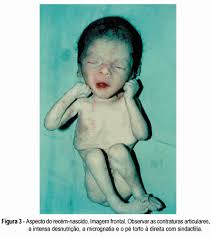
- Range of motion.
- Muscle strength.
- Developmental of gross and fine motor skills.
- Developmental of hand skills, grasp, and prehension
- Balance and postural control
- Self-perception
- Family and social support
- Daily living skills
- Play skills
- The disorder is usually characterized by rigidity and/or contractures of the joints.Typically, in the upper extremities , the shoulders are adducted and internally rotated, the elbows are extended but occasionally flexed, the forearms are pronated, the wrists are flexed and ulnary deviated, the fingers are flexed, and the thumb is in the palm. In the lower extremities, the hips may be dislocated and are usually flexed and externally rotated, the knees are extended but occasionally flexed, and the feet are in equinovarus.
- There is usually severely limited range of motion in all major joints.
- Muscle weakness usually occurs.
- The person may have absence or atrophy of individual muscle or muscle groups.
- The person may ave gross abnormalities of the chest and spine (myopathic type).
- Other problems include webbing on the ventral aspects of flexed joints, cleft palate, scoliosis, torticollis, facial palsy, limb deformity, and congenital amputation.
- Achievement of gross and fine motor skills is usually delayed
- Development of hand functions is usually delayed.
- Parents, especially the mother, may feel guilt about having a handicapped child.
- Child may have tantrums due to frustrations.
- Increase and maintain range of motion through activities, such as exercise and stretching.
- Promote achievement of gross and fine motor skills.
- Improve posture and positioning through the use of adapted equipment, such as corner seats, strollers, swivel buckets, or parapodiums.
- Provide splints to maintain gains in range of motion or serial casts to increase range of motion.
- Provide opportunities for learning and encourage child to explore problem-solving methods.
- Provide information to parents about the disorder and encourage parental participation in the therapy program. They should understand the importance of having the child wear splints until bone matures and continuing range of motion activities everyday so the child maintains use his/her body
- Provide information about community resources and services.
- Provide information about normal growth and development.
- Provide information about architectural and environmental barriers.
Arthrogryposis Multiplex Congenita
Arthrogryposis multiplex congenita (AMC) is a nonprogressive neuromuscular disorder present birth that is characterized by fibrous ankylosis (contractures) of multiple joints. Muscle development is arrested at some time during the fetal period and fibrous or fatty tissue replaces the muscle, resulting in contractures and abnormal joint surfaces. Types of AMC include neuropathic, myopathic, and mixed.
Assessment
Areas:
Instruments:
No specific instruments have been developed by occupational therapists to deal with this disorder. The following may be useful:
· Developmental assessment
· Activities of daily living scale
· Play history
Problems
Motor:
Sensory
Sensory system is intact, but perceptual skills, such as stereognosis, could be delayed due to lack of opportunity.
Cognitive
Cognition is normal and intelligence is average to above average, but learning could be delayed due to lack of opportunity and many surgical procedures.
Intrapersonal
Interpersonal
Family members may reject the "funny looking" child and leave the parents or mother without support.
Productivity
Play skills are usually underdeveloped.
Leisure
See productivity.
Treatment/Management
Motor
Sensory
Provide opportunities to experience sensory input.
- Provide opportunities to develop self-perception through the use of creative activities, such as art, crafts, drama, dance, music, and games.
- Encourage parents to express feelings and concerns about the child's condition and welfare.
- Provide instructions in stress-management techniques.
- Encourage parent-infant bonding.
- Encourage parents to participate in self-help groups.
- Provide self-help devices to assist in the performance of daily living skills. A lazy susan may be used as a plate. Food can be placed around the edge of the plate.
- Adapted equipment may be necessary for grooming, such as extended handles on combs, brushes and toothbrushes.
- Clothing adaptation may be needed to account for various deformities, using Velcro and elastic. Providing large rings on zippers or loops to grasp and large button is also useful.
- Promote development of play skills, especially exploratory and manipulative play.
- Assist teachers in determining what, if any, adapted equipment or devices may be needed to assist a child with academic activities. Computers with adapted keyboards may be helpful. the child should be able to attend regular classroom instruction, except for physical education.
- The person has maximum range of motion possible given structural limitations.
- The person achieves gross and fine motor skills, although the development of skills does not progress normally.
- The person has functional hand skills, although the use of the hands may be unorthodox.
- The person has independently mobility with or without powered mobility.
- The person achieves independence in self-care and daily living skills.
- The person develops productive skills.
Self-Care
Productivity
Leisure
Usually no special goals or objectives are necessary. The child or an adult will seek those activities that are within the child's functional abilities.
Precautions
Bone structure is fragile. Range of motion and stretching exercises should be carefully monitored.
Prognosis/Outcome




Thank you so much! I am studying for my certification exam in occupational therapy and this helped me to have a better understanding of arthrogryposis.
ReplyDelete